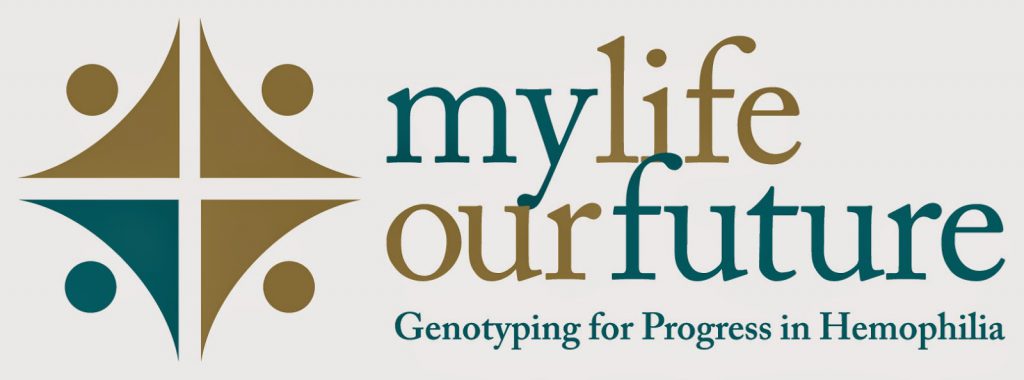1,033
 Last summer, I blogged about a new program called My Life, Our Future, a nationwide initiative between NHF, ATHN, Puget Sound Blood Center in Seattle and Biogen Idec that offers free genotyping to people with hemophilia in the US. As you may have seen around NHF’s Twitter chat on 7/23, the program has since successfully enrolled more than 1,000 participants! This is a significant milestone for the program and a great example of our community joining together and taking action to help advance scientific breakthroughs.
Last summer, I blogged about a new program called My Life, Our Future, a nationwide initiative between NHF, ATHN, Puget Sound Blood Center in Seattle and Biogen Idec that offers free genotyping to people with hemophilia in the US. As you may have seen around NHF’s Twitter chat on 7/23, the program has since successfully enrolled more than 1,000 participants! This is a significant milestone for the program and a great example of our community joining together and taking action to help advance scientific breakthroughs.During the chat, the community showed great interest in the
program and how it works. There are two components to My Life, Our Future (or “MLOF”). The first is a blood test that enables people to learn more about the specific genetic mutation that causes their hemophilia. Already, 61 new mutations have been discovered through the
program. Participants also have the option to contribute their data and samples to a central repository. Once 5,000 people contribute to this research “bank,” scientists will be able to study the data and samples, potentially leading to improvements in care and treatment.
program and how it works. There are two components to My Life, Our Future (or “MLOF”). The first is a blood test that enables people to learn more about the specific genetic mutation that causes their hemophilia. Already, 61 new mutations have been discovered through the
program. Participants also have the option to contribute their data and samples to a central repository. Once 5,000 people contribute to this research “bank,” scientists will be able to study the data and samples, potentially leading to improvements in care and treatment.
Getting Involved for Future Generations
Guy Law of Erie, PA, participated in MLOF for just that reason. “Hope comes to mind when I think of MLOF,” says Guy. “I hope my participation
in the program can positively impact families with hemophilia in the future.” Guy, who has severe hemophilia A and has long been an advocate in the
community, learned through MLOF he has a unique mutation. “I know the word “cure” gets thrown around and I’ve accepted the fact that in my lifetime there may not be one,” he said. “But if I can contribute to a research project that may eventually lead to a treatment breakthrough, I’m happy to.”
in the program can positively impact families with hemophilia in the future.” Guy, who has severe hemophilia A and has long been an advocate in the
community, learned through MLOF he has a unique mutation. “I know the word “cure” gets thrown around and I’ve accepted the fact that in my lifetime there may not be one,” he said. “But if I can contribute to a research project that may eventually lead to a treatment breakthrough, I’m happy to.”
Dr. Barbara Konkle, director of clinical and translational research at Puget Sound Blood Center, hopes that everyone with hemophilia A and
B participates in MLOF because of its value today and tomorrow. “Genotyping provides meaningful information about a person’s hemophilia,” said Dr. Konkle. “By building a robust bank of data and blood samples for researchers to study, we can deepen our understanding of the disorder and hopefully advance the science.”
B participates in MLOF because of its value today and tomorrow. “Genotyping provides meaningful information about a person’s hemophilia,” said Dr. Konkle. “By building a robust bank of data and blood samples for researchers to study, we can deepen our understanding of the disorder and hopefully advance the science.”
Interested in participating? The program is currently available at 42 HTCs across the country, and expanding to additional locations regularly. Visit the MLOF site to see if your HTC is offering the program.
MLOF By the Numbers
•
MLOF is now available at 42 hemophilia treatment centers in 26 states
MLOF is now available at 42 hemophilia treatment centers in 26 states
•
80% of participants have opted to participate in the research repository
80% of participants have opted to participate in the research repository
•
61 new mutations have already been found
61 new mutations have already been found
•
Once 5,000 people have consented to participate in research,
scientists at academic institutions or companies can apply to study the data
and samples
Great Book I Just Read
Once 5,000 people have consented to participate in research,
scientists at academic institutions or companies can apply to study the data
and samples
Great Book I Just Read
Flight 232: A Story of Disaster and Survival
Sioux City, July 1989: one of the worst aviation disasters ever. A DC10 cart wheeling on the tarmac
after the hydraulics completely fails. Gonzales tells the story of the crash
over and over, through different angles by probing the different experiences of
many involved: survivors, crew, rescue workers. His excellent research in interviewing
so many who lived through this puts you there; he also delves deeply into the engineering
flaws that led to the crash. You will learn a lot about titanium. And that so
much of survival in an airplane is sheer luck. It is amazing that so many
survived the crash; the pilots were absolutely heroic. Gonzales is an expert on
survival, and follows the survivors just after the crash and then a year later.
The testimonials are surprising—what goes through someone’s mind, as a plane is
disintegrating—and poignant. The most important thing in our lives is
relationships, most conclude. Four/five stars.
after the hydraulics completely fails. Gonzales tells the story of the crash
over and over, through different angles by probing the different experiences of
many involved: survivors, crew, rescue workers. His excellent research in interviewing
so many who lived through this puts you there; he also delves deeply into the engineering
flaws that led to the crash. You will learn a lot about titanium. And that so
much of survival in an airplane is sheer luck. It is amazing that so many
survived the crash; the pilots were absolutely heroic. Gonzales is an expert on
survival, and follows the survivors just after the crash and then a year later.
The testimonials are surprising—what goes through someone’s mind, as a plane is
disintegrating—and poignant. The most important thing in our lives is
relationships, most conclude. Four/five stars.


